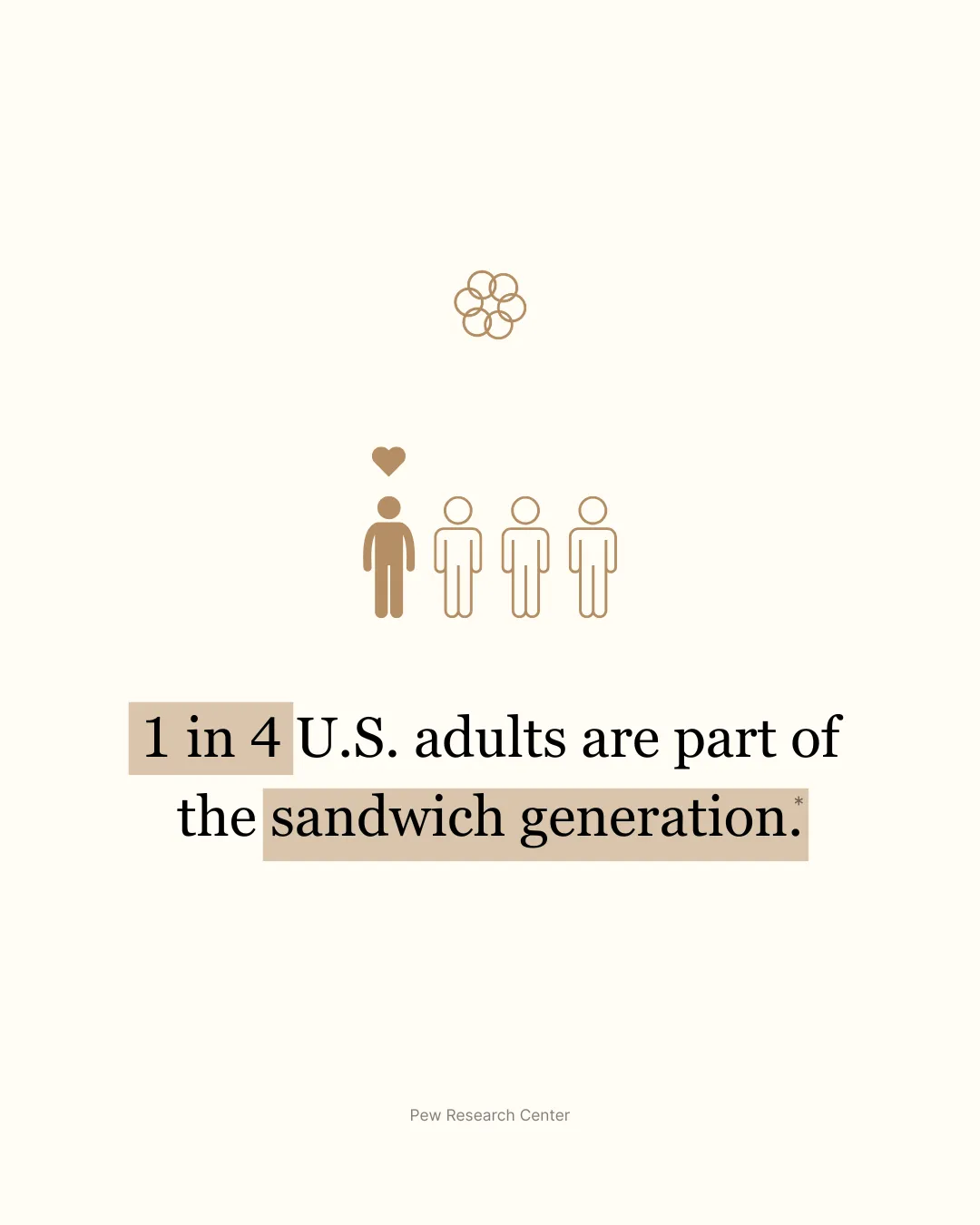Sandwich Generation: Meaning, Challenges, and Support

Caring for loved ones is never simple, but an increasing number of adults find themselves stretched between two generations. They’re raising their own children while also helping aging parents who need more support. This growing reality has been given a name: the sandwich generation.
We’ll be referencing AARP’s Caregiving in the U.S. 2025 report throughout this article, as well as insights from the American Psychological Association (APA). These sources highlight just how widespread and complex this caregiving role has become.
This group faces unique pressures that go beyond traditional parenting or elder care. In this blog, we’ll explain the sandwich generation meaning, how many people fall into this role, the challenges they experience, and the resources available to help.
What is the sandwich generation?
At its core, the sandwich generation refers to adults who are caring for both younger children and aging parents simultaneously. These individuals are often in their late 30s to early 60s, juggling multiple responsibilities on top of careers, households, and their own health.
The term was first coined in the early 1980s by social workers Dorothy Miller & Elaine Brody, who used it to describe middle‑aged adults squeezed between the demands of raising children and supporting aging parents. At that time, the phenomenon was just beginning to gain recognition as a social and economic issue.
As Americans began living longer, and adult children increasingly became responsible for two sets of dependents, the label stuck. Over the decades, the concept has been extensively studied in sociology and psychology, with increasing public awareness. Today, the trend continues to grow as people are waiting longer to have children, and life expectancy increases.
According to the APA, the pressures on the sandwich generation have gained more visibility in recent years due to shifting demographics, changing family structures, and rising financial demands.
What are the sandwich types?
Researcher Carol Abaya expanded the concept in the 1990s by identifying different "types" of the sandwich generation. She described:
- Traditional Sandwich: Adults caring for their own children while simultaneously supporting aging parents.
- Club Sandwich: Adults in their 50s or 60s sandwiched between aging parents, adult children, and grandchildren. It can also apply to younger adults who care for children, parents, and grandparents simultaneously.
- Open‑Faced Sandwich: Anyone, such as friends, neighbors, or community members, who helps to provide elder care without being a direct family caregiver.
These categories highlight the diverse ways people may feel “sandwiched” between caregiving roles, showing that the experience isn’t limited to just parents with minor children and elderly parents.
Sandwich Generation Meaning in Everyday Life
The sandwich generation's meaning becomes clear when looking at everyday situations. Imagine someone in their 50s with two teenagers at home. At the same time, they may be managing medical appointments for their 80-year-old mother or helping their father with household tasks.
This dual responsibility creates emotional and financial pressure. They may feel guilty for not having enough time for their kids or resentful that their own goals are on hold. At the same time, they’re often covering rising expenses, from tuition and sports fees to prescription medications and home modifications for parents.
According to APA, this group often experiences high levels of stress, with many reporting anxiety, depression, or burnout. These challenges make it even more important for families to find systems of support.
How many people are in the sandwich generation?
Research from Pew Research Center and AARP shows how widespread this role is. AARP’s Caregiving in the U.S. 2025 estimates that 63 million U.S. adults, about 24% of all adults, provided unpaid care in the prior 12 months. Within that total, approximately 16 million are members of the sandwich generation, balancing care for an adult and a child under 18 at the same time. The average caregiver is 51 years old, and many care recipients are 75+ with multiple chronic conditions.
Nearly one‑third of all caregivers care for both an adult with disabilities or complex medical conditions and a child under 18 at home; among caregivers under age 50, that share rises to 47%. Many caregivers provide intensive support, spending an average of 27 hours per week caring for their loved ones, and approximately 24% dedicate 40 hours or more per week to this task.
Living arrangements also shape intensity. 40% of caregivers live with their care recipient and 35% live nearby. Those living together provide more hours and are less likely to have paid or unpaid help.
This number is expected to rise as both Baby Boomers and Gen Xers age, leaving Millennials and Gen Z in similar sandwiched positions in the coming decades. These caregivers represent a diverse range of backgrounds, including single parents, married couples, blended families, and individuals from various cultural backgrounds. While each family looks different, the pressure of being pulled in two directions remains the same.

Unique Challenges Faced by the Sandwich Generation
The sandwich generation experiences a distinct set of challenges that go beyond caregiving for one group alone. Emotionally, many report feeling overwhelmed, guilty, or burned out. They want to do their best for both their kids and their parents but often feel like they are failing one side.
Nearly two‑thirds (64%) report moderate or high emotional stress, and 45% report moderate or high physical strain. 24% report feeling alone. According to APA, stress can intensify when parents are simultaneously raising children and caring for aging relatives, with midlife mothers historically reporting some of the highest stress levels.
Financially, these adults face immense pressure. About 47% of caregivers report at least one negative financial impact related to caregiving. Common impacts include stopping saving (31%), using up short‑term savings (24%), using long‑term savings (13%), taking on more debt (23%), leaving bills unpaid or paying late (20%), and being unable to afford basic expenses like food (14%). Lower‑income caregivers and caregivers of color more often report these impacts.
Career impacts are significant as well. Among working caregivers, nearly half report schedule disruptions such as arriving late, leaving early, or taking time off. Others reduce their work hours (18%), take a leave of absence (16%), decline promotions (9%), or even leave the workforce (9%).
Finally, relationships and personal identity can shift. Marriages and friendships may suffer as energy is redirected toward caregiving, and personal goals often take a backseat to daily responsibilities.
How the Sandwich Generation Manages Responsibilities
Despite the difficulties, many families develop strategies to make the role more manageable. Sharing responsibilities among siblings, relatives, or close friends helps spread the load. For those without extended family support, leaning on community resources can make a difference.
Open communication within the family is also vital. Parents, children, and partners need to express needs and set realistic expectations to avoid resentment or burnout. Scheduling dedicated time for family bonding or self-care, even if limited, can help maintain balance.
Some turn to professional support, such as hiring part-time caregivers, using financial planners, or working with elder care coordinators. While not always affordable for everyone, these services can provide valuable relief.
Support and Resources for the Sandwich Generation
The good news is that there are resources designed to support the sandwich generation. Financial planning tools can help families budget for multigenerational care and prioritize savings. Employers are also beginning to recognize the needs of working caregivers, offering flexible hours, paid leave, or employee assistance programs.
Technology is playing an increasingly significant role in managing these responsibilities. Apps like Caily, for example, bring medical information, appointments, and caregiving updates into one secure place, making it easier to keep family members in sync.
Equally important is emotional support. Counseling, caregiver support groups, and mental health resources can provide a safe outlet for stress and reduce feelings of isolation. According to APA, support groups also create a sense of community that helps caregivers feel less alone.

Looking Ahead: The Future of the Sandwich Generation
As populations age, the sandwich generation will continue to expand, with more adults balancing the needs of children and aging parents at the same time. This reality underscores the importance of stronger workplace policies, expanded caregiving benefits, and greater public awareness. Supporting these caregivers means supporting families as a whole, ensuring they can provide care without sacrificing their health, financial stability, or well-being.
Technology can also make this role more manageable. Caily brings family schedules, health information, and caregiving updates into one secure hub, helping families stay organized and connected across generations. By streamlining tasks, offering daily check-ins, and creating a shared space for communication, Caily helps lighten the load for those juggling multiple responsibilities.
The sandwich generation is a vital part of modern family life. These adults shoulder the responsibility of caring for both children and aging parents, often with limited time and resources. While the role can be overwhelming, tools like Caily, combined with thoughtful planning and community support, make it possible to navigate caregiving more effectively. Most importantly, no one in the sandwich generation is truly alone; with the right mix of support and resources, balance and fulfillment are within reach.
FAQs About Sandwich Generation
What is the sandwich generation?
The sandwich generation refers to adults who are simultaneously responsible for caring for their own children while also supporting their aging parents, often emotionally, financially, and physically.
Why is it called the sandwich generation?
It’s called the sandwich generation because these individuals feel “sandwiched” between two caregiving roles—supporting younger children and older parents at the same time.
How can the sandwich generation cope with stress?
Coping strategies include setting boundaries, sharing caregiving responsibilities with siblings or partners, seeking community resources, using technology to stay organized, and prioritizing self-care.

Get Started Now
Enjoy full access to everything Caily offers, from medication tracking to shared schedules and daily check-ins. See how much easier caregiving can be when everything is coordinated in one place.
Start your free trial
